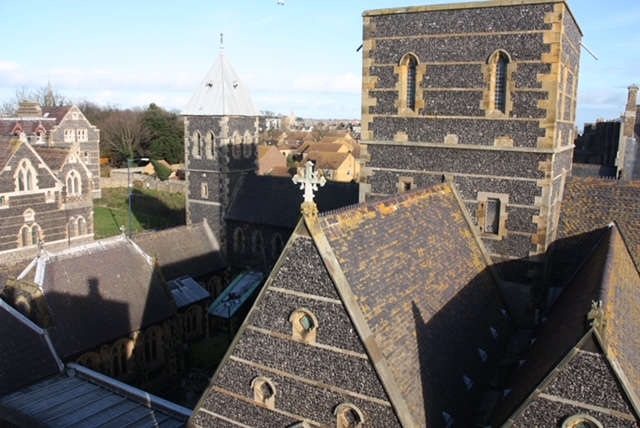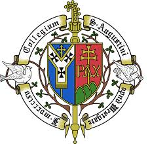Architectural Review, April-May 2012, 'Profile'.
THE DELIGHT OF THE SEA WITH CATHOLIC ARCHITECTURE AND A LIBRARY: PUGIN'S GRANGE AND ST AUGUSTINE'S ABBEY AT RAMSGATE
Copyright: William J. R. Curtis, April 2012
This year marks the bicentennial of the birth of Augustus Welby Pugin (1812-1852) and the event is being celebrated in numerous seminars and publications. Pugin it will be remembered was a champion of a branch of the Gothic Revival in the service of a renewed public presence of Roman Catholicism in England. In his short but intense life he succeeded in designing numerous parish churches with all their decorations, furniture and accoutrements, in contributing with Charles Barry to the design of the Houses of Parliament, in reinventing domestic architecture along more functional lines, and in writing and illustrating several tracts, the most notable being Contrasts, A Parallel Between the Noble Edifices of the 14th and 15th Centuries and Similar Buildings of the Present Day, Shewing the Decay of Present Taste (1836) and The True Principles of Pointed or Christian Architecture (1841). In parallel with the revivalism of his actual buildings Pugin set in place attitudes concerning the 'honesty' of materials and structure which contributed (paradoxically) to moralizing prejudices of the early modern movement. Meanwhile his direct solutions to domestic planning nourished the Arts and Crafts Movement and contributed to the very idea of the English suburban home with its irregular silhouettes, gables and rooms protruding into gardens.
Pugin was a fierce critic of the crass materialism and social exploitation of the early Industrial Revolution and imagined a return to a mythical pre-Reformation society of true Christian values and architectural forms serving the Faith. His position was well illustrated in the plates of Contrasts. In the second edition he contrasted the modern poor-house in the form of a panopticon (the corrective instrument of Jeremy Bentham's Utilitarianism) with the radiant Medieval priory with its church, monastery, orchards and Christian charity. At the same time, he was opposed to all forms of classicism which he associated with the vainglorious society of the Regency period and with the paganism of classical antiquity. If there is a single work which most clearly embodies his world view it must surely be the complex of buildings at St Augustine's Abbey in Ramsgate (designed 1843-4) combining on one side his own house, the Grange, and on the other the Abbey Church itself, with its attached cloister, graveyard and gardens.
"I have purchased a fine piece of land, about an acre facing the sea at Ramsgate close to the point where the blessed Austin (St Augustine) landed. I shall not erect a Grecian Villa but a most substantial Catholic house not very large but convenient and solid and there is every prospect of a small church in the same ground which will be delightful. When this is finished, I shall hope to induce you to come to me and enjoy what is to be so rarely attained - the delight of the sea with Catholic architecture and a library!"

The Grange is sited so that it affords views both south towards the English Channel (with its trecherous Goodwin Sands) and more to the west towards Pegwell Bay and Ebsfleet, where St Augustine is supposed to have landed in 597 bringing Christianity to a part of Britain. The Library, where Pugin worked day and night, frames these two views through its windows which have stained glass in the upper panes and plainglass in the lower ones. The floor is quite high with respect to the garden and the sense of the sea horizon is immediate the moment one enters this room. The rich decorations of the interiors allude to the French Fleurs de Lys (Pugin's father was a French aristocrat who escaped the Revolution) and to the raven clutching a poisoned loaf of bread which, according to legend, saved the life of St Benedict (480-547), the founder of Western monasticism in the Monastery of Subiaco in Lazio. The raven motif is found everywhere in the Grange and the Abbey Church, even in the floor tiles. Pugin thus knowingly elaborated two foundation myths in this refoundation of Catholicism in England. In fact, the first monks to eventually move into the Abbey belonged to the Subiaco Order of Saint Benedict. Pugin's fervent faith did not go down too well with a snobbish local Ramsgate society of retired military from the Napoleonic wars who distrusted 'Papists’, nor eventually with the official church of Rome which distrusted his radicalism.
One of the most striking features of the Grange is the tower with the very tall flagpole. As it happens, Pugin had a second line of business which was quite lucrative: he owned a lugger called 'The Caroline' which specialized in salvage operations from ships wrecked on the Goodwin Sands. From the tower Pugin had a long view of the shipping passing through the English Channel and was in the habit of wearing a trim naval jacket of the kind affected by sea captains of the time. This was still the epoch of sail on the sea, and of horse and carriage on land: the steam age was only just beginning to impinge on East Kent and the first railway did not come to Ramsgate until a little later. The Grange and Abbey can certainly be situated in the larger annals of the several Gothic Revivals (despite differences, Ruskin could never have been the same without Pugin) but they are also poignant memorials of an extraordinary personality who marked his age.
As it happens,I went to school at St Augustine's between the ages of seven and thirteen, first of all as a day boy taking the train back and forth from Birchington-on-Sea every day, then as a border who lived some of the time at the Grange. In those days the house was somewhat run down but it was full of atmosphere (it has since been restored and managed by the Landmark Trust). The Channel winds were always howling around the towers, and the sea was part of our daily experience. One of the upstairs rooms looked out towards Pegwell Bay and I was totally aware of the arrival of St Augustine, of the Danes, even probably of Julius Caesar, on that flat Kent coastline. As for the Abbey Church, it marked me for life. The exteriors were grim, especially in the winter, but the interiors were glowing with candles, gold leaf, ornament and conviviality. The Abbey and Grange joined Canterbury Cathedral, Reculver Towers, Ingoldsby Court and Weyborough Manor as essential parts of a boyhood spent on the Isle of Thanet exploring the marshes and messing about in boats. And of course, like any mariner I was acutely aware of the contrast between Pugin's view south to the English Channel and my home view north towards the horizon of the North Sea – that same seascape celebrated by Pugin's older contemporary J. M.W. Turner in his sublime portrayals of storms and sunsets.
Copyright: William J. R. Curtis, April 2012
